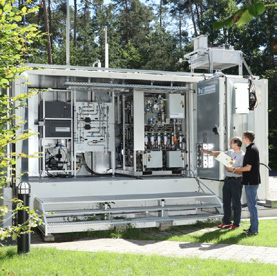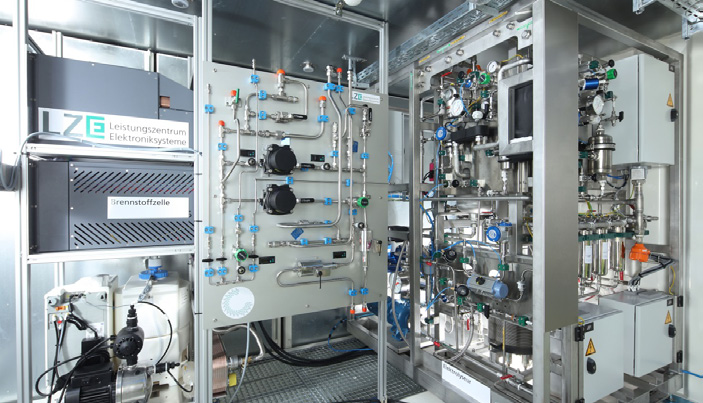A container full of energy
It does seem quite cramped when you enter the 20-foot steel container at Fraunhofer IISB. Inside is hydrogen technology for the storage and release of electrical energy on a large scale. The Leistungszentrum Elektroniksysteme LZE is researching on a safe and clean energy supply for industrial firms and large building complexes based on this technology.


Energy storage with LOHC technology
Chemical hydrides are one way of safely storing surplus energy – from local photovoltaic plants, for example – for longer periods and to make it available for energy-intensive systems.
The LZE pilot project “DC-Backbone mit Strom-Gas- Kopplung” (DC backbone with electricity- gas coupling) makes use of a liquid organic hydrogen carrier, called LOHC. This makes it possible to store large quantities of electrolytically generated hydrogen and to store it safely at the usual ambient pressure and temperature. In order to generate electricity from the hydrogen, a PEM fuel cell (PEM = proton exchange membrane) is used. The PEM technology means that the fuel cell is operational within a few minutes, which is important to smooth load peaks. The carrier is not consumed when storing and releasing the hydrogen, and it can potentially be used for several hundred cycles. The current prototype would be able to store enough energy to cover the power requirement of a small industrial company for several hours. Additional tank containers allow the quantity of stored energy to be increased by several magnitudes.
“Only interdisciplinary cooperation will ensure the success of our research project,” explains deputy project manager Michael Steinberger. The necessary know-how for LOHC technology is supplied by the Institute of Chemical Reaction Engineering (CRT) at the Friedrich Alexander University of Erlangen-Nürnberg; the Fraunhofer Institute for Integrated Circuits IIS is providing support for the control technology.
Research questions and aims
The researchers intend to use the new facility to investigate various questions: how can an LOHC-based energy storage system be operated to store energy from fluctuating sources? How can systems of this kind be integrated into a single container in a compact manner? How can a facility of this nature be efficiently incorporated into industrial energy grids? With the right operating strategy, the LOHC system will make it possible to incorporate renewable energies in industrial energy systems on a large scale while also guaranteeing supply reliability.
Last modified: